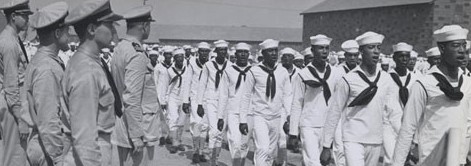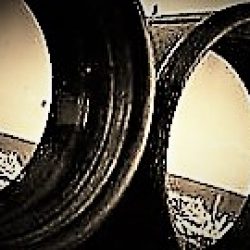The claim that the Port Chicago explosion was the result of a nuclear bomb test was first made by Peter Vogel who published an article, The Last Wave from Port Chicago, in the Spring 1982 edition of Black Scholar Magazine. Vogel later published an ebook with the same title. (In December of 2018 he shut down the site permanently. Versions of the ebook are available either through subscriptions or via the Internet Archive.)

Was It A Nuclear Explosion?
The Port Chicago nuke theory (PCNT) was challenged by historians Lawrence Badash and Richard Hewlett in a 1982 article, “A Story Too Good to Kill: The “Nuclear” Explosion in San Francisco Bay”. Their case against the theory isn’t very strong. Some of the arguments don’t even apply to the claim but are raised by the authors. For example, they raise a flimsy “straw man” argument against the likelihood that President Roosevelt would have instigated such a plot, and discount their own illogical suggestion that a “maverick” test would have had to be conducted outside of the Manhattan Project.
The strength of the Badash / Hewlett article is its reference to scientists who have refuted the claim. H. Pierre Noyes, an antiwar activist who was a theoretical physicist at Stanford, laid out his arguments against the claim in an unpublished letter responding to “RW” in Oakland, California who sought his input regarding the PCNT.
(It appears from a related document that RW stands for Revolutionary Worker, a newspaper published in the 1980s by the Revolutionary Communist Party, USA.)
A THEORY TOO IMPORTANT TO IGNORE
Although Noyes respected the serious nature of the Vogel article, he found the idea of a nuclear explosion at Port Chicago unbelievable. On the other hand, he reports, Vogel’s research set forth a viable claim that a nuclear bomb may have been available by late 1944, before the German surrender.
Noyes states that if that was the case, it calls into question the official explanation that the bomb was not used against Germany because it wasn’t ready in time. If the official claim is not true it reinforces the charge that the decision to use the bomb against Japan was race-based. While he finds this idea repulsive and unbelievable, Noyes points out that the Watergate story began as coverage of an inept burglary.

Because he believed it was in the national interest to clear up this uncertainty, Noyes wrote to about a dozen colleagues, asking their input.The list includes Hans Bethe and several other Manhattan Project scientists who, Noyes says, would never have participated in any cover-up. He believed they would also be concerned that the issue be laid to rest. Whether and how any of them may have responded is a subject that awaits further research.
BASES OF THE DEBATE
In the first five pages of his letter to RW, Noyes lays out his arguments against specific points made in The Last Wave. His arguments cover the typical objections to the theory. In a future post, The PCW will review the original claims and objections along with fresh counterarguments; but first there are two important considerations to bear in mind.
In the first place, the claim presented in The Last Wave centers on technical details unearthed through decades of diligent research by Peter Vogel. Even Badash and Hewlett acknowledge that Vogel asked good questions and consulted the right sources; it’s his conclusions they question. For reasons to be explained in a future post, the PCW finds Vogel’s logic far more compelling.

The PCW briefly revisits the arguments on both sides before turning to the revealing human elements: who would have conducted such a test? Why? How? How could they have gotten away with it and kept it secret?
The PCW presents the “testimony” of historical witnesses through examination of primary and secondary sources, including declassified government documents and a variety of books by professional historians.
Additionally it is important to note that all objections to the PCNT so far have been based on the technical details of the claim set out in The Last Wave. Again, The PCW provides a different treatment of the facts in the case.
Above all, the original claim alleges that the device detonated at Port Chicago was a uranium gun-assembly model like the “Little Boy” bomb that was dropped on Hiroshima. Vogel’s argument is based on
- the finding of Manhattan Project scientists that plutonium would be ineffective in a gun-type bomb; and
- Vogel’s finding that there was enough uranium available by mid-1944 to not only produce and test a uranium gun but to also build combat-ready weapons. (This is the point that raised Noyes concern about the official reason no atomic bomb was used on Germany.)
Arguments based on a uranium gun do not necessarily apply to a plutonium device. The PCW presents a scenario that hasn’t been sufficiently addressed: what if a plutonium gun-type bomb like the “Thin Man” could have been tested at Port Chicago after all?
BEYOND BELIEF
Americans first learned of the atomic bomb on August 6, 1945, hours after the first one was dropped on Hiroshima. President Truman was returning from the Potsdam Conference in Berlin and made the announcement by radio from aboard the USS Augusta.
The initial reaction of Americans was overwhelming relief: the Japanese would surely surrender after such an attack. The war would soon be over. “Our boys” would be coming home. That was the most important thing.

War nears end.
Our boys home soon!
It seems everyone accepted Truman’s description of the revolutionary new weapon without question. The President said the single bomb was the equivalent of 20,000 tons of TNT.
He said men had harnessed “the basic power of the universe. The force from which the sun draws its power…”

to produce “...the largest bomb ever yet used in the history of warfare”.
Truman announced that the nation had spent two billion dollars — 1940s dollars —
“on the greatest scientific gamble in history . . . the greatest achievement of organized science in history”.

Hearing was believing. On October 30, 1938, the CBS broadcast of Orson Welles “War of the Worlds” had been so realistic it caused a nationwide panic. There were unconfirmed reports that some people had committed suicide rather than face the Martian invasion.

Radio was a powerful medium; the president was The President. Ever since the banking crisis of 1933 the country had grown accustomed to the folksy fireside chats of President Franklin D. Roosevelt.
August 6, 1945. Americans listening to the radio learn that the U. S. has dropped an atomic bomb, destroying the city of Hiroshima. Up to 100,000 Japanese civilians are killed in the attack. Three days later the U.S. drops a second nuclear weapon on Nagasaki.

Today, despite — or possibly because of — ready access to the internet and all manner of social media,

Americans find it hard to believe that the Government may have tested a nuclear device at Port Chicago 75 years ago…

…but stranger things have certainly happened.


Hmmm.


